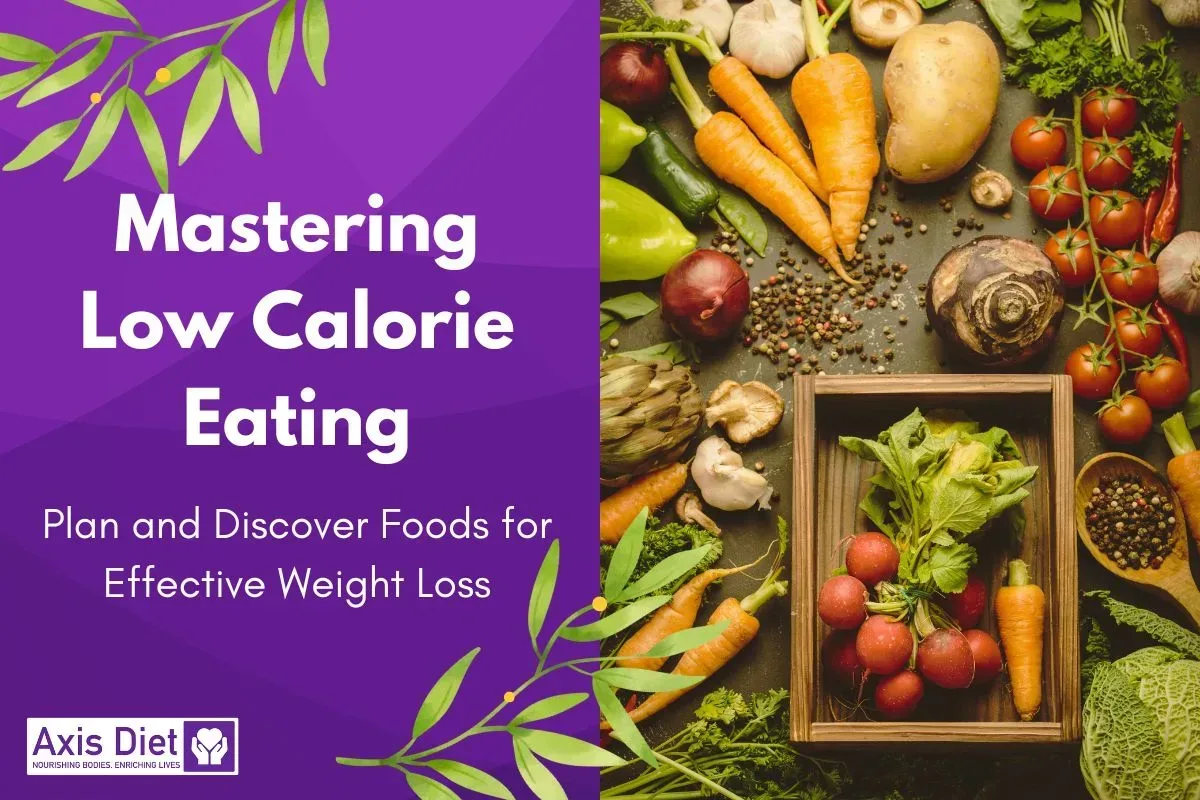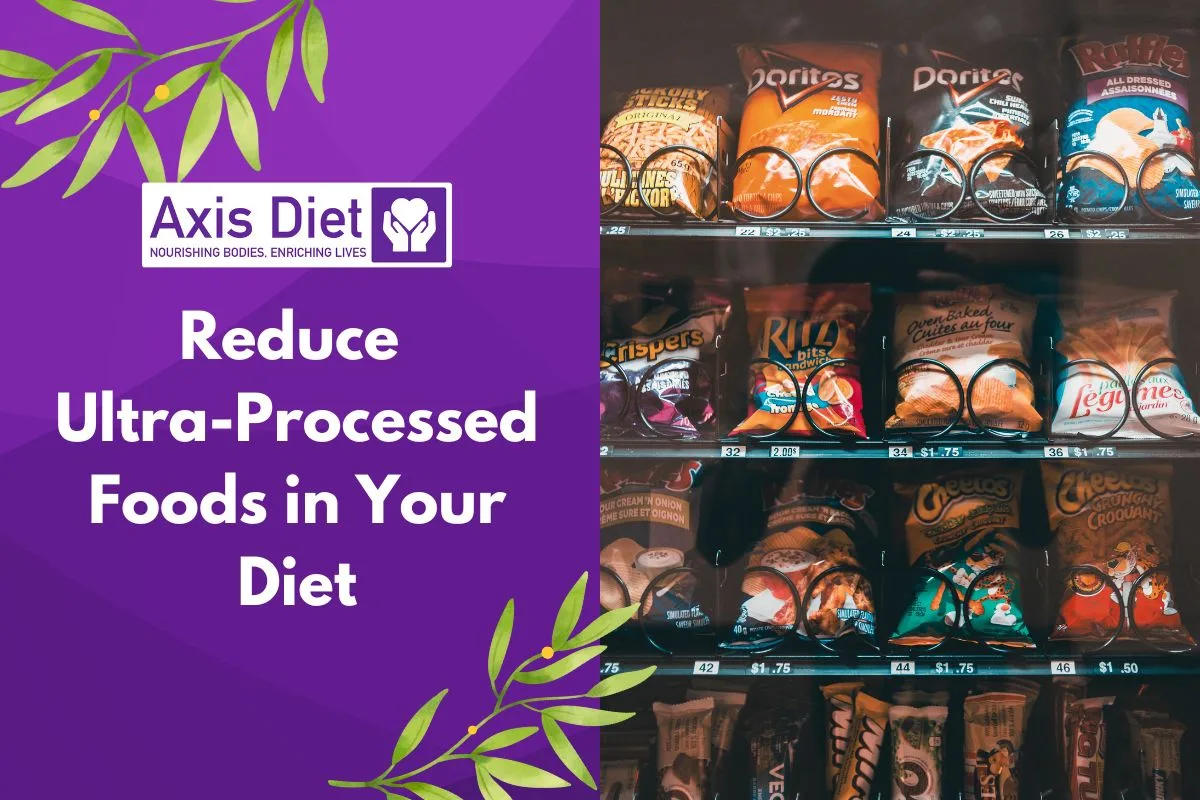Do you often find yourself reaching for chips or ice cream, only to feel hungry again soon after? This is a common issue with high-calorie foods – they don’t fill you up and lead to overeating. Studies show that regularly eating these foods can create a habit hard to break. On the positive side, low calorie, high-volume foods can help control hunger and manage weight. They are rich in nutrients, fiber, and water which keep you full and nourished. Why not try these foods to stay fit? At Axis Diet, we help you explore these filling, low-calorie options for a healthier lifestyle.
How to identify low calorie, filling food?
Rich Fiber Makeup
The generous fiber in low-calorie, filling foods is a blessing for digestion. Acting as a natural regulator, fiber helps in smoother digestion. It also fights against inflammation and cholesterol, improving heart health. Besides, fiber acts as a prebiotic, nourishing good gut bacteria, enhancing gut health and immune function.
High Nutrient Density
These foods are packed with essential vitamins and minerals, forming the foundation of a balanced diet. They support immune health with antioxidants and provide essential minerals for bone health, all without excessive calories.
Abundant Water Content
Explore the hydration benefits of fruits and vegetables, where water is a major component. This water content helps you feel full, acting as a natural guard against overeating. The hydration from these foods goes beyond just filling you up, aiding in overall body functions and skin health. By adding more of these hydrating foods to your diet, you curb calorie intake and promote a hydrated, vibrant self.
Low-Calorie Density
Low-calorie, filling foods are perfect allies for weight management. They allow for satisfying portion sizes without adding too many calories, making them crucial for those looking to lose or maintain weight. They help combat overeating by filling your plate and stomach without overloading on calories.
Minimal Fat Content
The low fat content in these foods helps reduce calorie intake while still providing essential fatty acids necessary for bodily functions. They balance nourishment and calorie control, allowing for satisfying meals without high-calorie intake, aiding those on a weight management journey.
Generous Protein Provision
With a good amount of protein, these foods help promote fullness and curb unhealthy cravings. Protein is essential for muscle repair and growth, and supports various bodily functions. These foods help maintain lean muscle mass, especially important for those engaging in regular physical activity.
Which foods are fulfilling and low in calorie?
1. Cucumbers (ककड़ी, Kakdi)
Cucumbers are excellent for hydration due to their high water content, which also helps in promoting fullness and aiding digestion.
Slice them into salads, mix with yogurt to make a refreshing raita, or simply snack on them with a pinch of salt and pepper.
2. Tomatoes (टमाटर, Tamatar)
Tomatoes are a good source of vitamins C, K, and potassium, which help in boosting immunity and promoting heart health.
Include them in salads, cook them in curries, or puree them to make a tangy tomato sauce for various dishes.
3. Spinach (पालक, Palak)
Spinach is a nutrient powerhouse rich in iron, calcium, and vitamins, which help in promoting blood health and strengthening bones.
Cook it in dishes like palak paneer, blend into smoothies, or toss fresh leaves in salads.
4. Mushrooms (मशरूम, Mashroom)
Mushrooms are low in calories and a good source of B-vitamins and selenium, promoting energy production and supporting immune function.
Sauté them with other veggies, add to stir-fries or grill and enjoy as a side dish.
5. Cauliflower (फूलगोभी, Phool Gobi)
Cauliflower is a versatile vegetable, low in calories and rich in vitamins C and K.
Make cauliflower rice, cook it in curries like aloo gobi, or roast with spices.
6. Broccoli (ब्रोकोली, Broccoli)
Broccoli is packed with vitamins, minerals, and antioxidants that support immune health and provide anti-inflammatory benefits.
Steam, roast, or stir-fry and enjoy as a side dish or include in salads.
7. Carrots (गाजर, Gajar)
Carrots are rich in vitamin A which promotes good vision, skin health, and immune function.
Snack on them raw, add to salads, or cook in soups and stews.
8. Bell Peppers (शिमला मिर्च, Shimla Mirch)
Bell peppers are low in calories and rich in vitamins A and C, promoting immune health and skin health.
Stir-fry, roast, or stuff with a filling of your choice.
9. Zucchini (ज़ूकिनी, Zucchini)
Zucchini is low in calories and a good source of vitamins C and B6.
Spiralize into noodles, slice into salads, or add to stir-fries and curries.
10. Lettuce (लेट्यूस, Lettuce)
Lettuce is low in calories and a good source of vitamins A and K, promoting bone health and providing antioxidants.
Use as a base for salads or as a low-carb wrap for various fillings.
11. Egg Whites (अंडे की सफेदी, Ande Ki Safedi)
Egg whites are high in protein, promoting muscle growth and aiding in weight management.
Cook as omelets, add to salads, or make egg white scrambles with veggies.
12. Lentils (दाल, Daal)
Lentils are nutrient-dense, providing protein, fiber, and various vitamins and minerals.
Cook into various dal recipes, use as a base for soups, or make lentil salads.
13. Green Beans (फाली, Fali)
Green beans are low in calories and a good source of vitamins A, C, and K.
Steam, stir-fry, or add to salads and casseroles.
14. Cabbage (पत्ता गोभी, Patta Gobi)
Cabbage is a low-calorie vegetable that provides a good amount of vitamins C and K.
Shred into salads, stir-fry, or cook in soups and stews.
15. Radishes (मूली, Mooli)
Radishes are low in calories and provide a good amount of vitamin C.
Slice into salads, pickle, or cook in soups and stews.
16. Okra (Lady’s Finger) (भिंडी, Bhindi)
Okra is low in calories and rich in fiber, aiding in digestion and promoting fullness.
Cook in dishes like bhindi masala or stir-fry with spices.
17. Bottle Gourd (लौकी, Lauki)
Bottle gourd is a low-calorie vegetable that provides a good amount of vitamin C.
Cook in curries, stews, or make lauki halwa for a sweet treat.
18. Pumpkin (कद्दू, Kaddu)
Pumpkin is low in calories and rich in vitamins A and C.
Cook in curries, soups, or bake into desserts like pumpkin pie.
19. Brussels Sprouts (ब्रसेल्स स्प्राउट्स, Brussels Sprouts)
Brussels sprouts are low in calories and rich in vitamins C and K.
Roast with a bit of olive oil and spices, or shred and add to salads.
20. Asparagus (ऐस्पैरगस, Asparagus)
Asparagus is low in calories and a good source of vitamins A, C, and K.
Grill, steam, or roast and enjoy as a side dish or add to salads and pastas.
Practical Tips to Navigate Your Journey of Low Calorie Meals
Below are actionable insights designed to guide you through this dietary transition, ensuring you’re well-equipped to relish the bounty of filling foods while aligning with your health aspirations. Each tip is a stride towards fostering a fulfilling and nourishing eating experience, paving the way for a harmonious relationship with food.
Shop Smartly for Your Health
Employing smart shopping strategies is your ticket to bringing home the finest of low-calorie, filling foods. It begins with understanding nutritional labels, deciphering the information to make informed choices. Opting for fresh, seasonal produce and avoiding processed, calorie-dense items are steps towards building a pantry that echoes with health and wellness. Smart shopping is not just about what you buy, but also about making choices that align with your health goals, ensuring that every grocery trip is a step towards better health.
Craft Your Meal Plan
Crafting a meal plan that encapsulates the essence of filling, low-calorie foods is akin to paving a roadmap towards a balanced and nutritious diet. It’s about orchestrating a daily menu that harmonizes different food groups, ensuring a melodious balance of essential nutrients. This practice not only aids in organized grocery shopping, reducing the chances of impulsive purchases but also minimizes food wastage. A well-thought-out meal plan celebrates the diversity of these foods, making the journey towards health a delightful experience rather than a restrictive chore.
Master the Art of Portion Control
Mastering the art of portion control is an indispensable step towards making the most of low-calorie, filling foods. It’s not just about measuring food but understanding the right serving sizes that satisfy hunger without leading to overindulgence. This skill transcends the dining table, promoting a balanced lifestyle. By embracing portion control, you can enjoy a diverse range of foods while keeping caloric intake in check, making weight management an achievable goal rather than a daunting task.
Relish Every Bite Mindfully
The practice of savoring each bite goes beyond mere eating; it’s a form of mindfulness that elevates the dining experience. It’s about immersing in the flavors, textures, and nourishment that these filling foods provide, fostering a deeper connection with the food you eat. Listening to your body’s satiety signals and appreciating the nourishment are practices that enhance the relationship between mind and body. This mindful approach to eating not only enriches the eating experience but also nurtures a healthy, balanced relationship with food.
Cultivate Patience in Your Transition
The transition to a filling eating approach may unfurl as a journey of discovery and adaptation. It’s about exploring new foods, tastes, and textures while nurturing a balanced relationship with food. Cultivating patience during this transition is essential, as your palate and body acclimate to the new way of eating. It’s a process of learning and unlearning, where patience becomes your companion, guiding you gently towards a lifestyle that resonates with health, satisfaction, and wholesome indulgence.
Conclusion: Journey to Healthy Eating
Starting a journey of eating low-calorie, filling foods is a great step towards a healthier life. It’s not just about losing weight, but also about enjoying food in a healthy way. The tips given above are like friends who help you on this journey. They guide you on how to eat smart, shop wisely, and enjoy every meal. As you follow these tips, you’ll find that eating healthy can be enjoyable and satisfying. It’s not just a one-time change, but a new way of enjoying food that’s good for you. So, take this step towards better health and enjoy the journey of tasty, filling, and healthy eating.
Frequently Asked Questions about Low Calorie Diet
What are the key characteristics of low-calorie, filling foods?
Low-calorie, filling foods are typically characterized by their high water and fiber content, which contribute to a feeling of fullness without adding excessive calories. They also often have a high nutrient density, meaning they provide a good amount of vitamins, minerals, and other beneficial nutrients with relatively few calories. The fiber content not only aids in digestion but also slows down the rate at which food leaves your stomach, promoting longer-lasting satiety.
How do low-calorie, filling foods contribute to weight loss and overall well-being?
Incorporating low-calorie, filling foods into your diet can be a cornerstone of effective weight management. They help to create a calorie deficit by filling you up with fewer calories, making it easier to lose weight or maintain a healthy weight. Additionally, the nutrient-dense nature of these foods supports overall well-being by providing essential nutrients required for the body’s various functions. Their high water content also contributes to hydration, which is crucial for almost every aspect of health.
What are some considerations for meal planning and shopping when focusing on low-calorie, filling foods?
When meal planning, prioritize a variety of low-calorie, filling foods to ensure a balanced intake of nutrients. Plan your meals around a protein source and fill the rest of your plate with a variety of vegetables, fruits, and whole grains. While shopping, stick to the perimeter of the grocery store where fresh produce, lean proteins, and whole grains are usually located. Read labels to understand the nutritional content of packaged foods, and choose those with fewer added sugars and unhealthy fats.
Can you provide some practical tips on how to incorporate more low-calorie, filling foods into daily meals?
Start by including a variety of colorful vegetables and fruits in your meals. Opt for whole grains over refined grains, and include lean protein sources like poultry, fish, legumes, and low-fat dairy products. Experiment with plant-based protein sources like lentils and chickpeas. When snacking, choose fresh fruit, vegetables with hummus, or a handful of nuts over processed snack foods. Moreover, when cooking, try methods like steaming, grilling, or roasting instead of frying to keep the calorie content lower.






[…] tool that promises precision and consistency in measuring food portions, which is the bedrock of effective calorie tracking and managing portion sizes. This is particularly critical for anyone striving to adhere to […]
[…] is integral to energy production in the body. It helps convert the food we eat into glucose, which is used as energy. A deficiency in B12 can result in fatigue, lethargy, and a […]
[…] meals in advance can reduce dependency on convenience foods. Plan a weekly menu that includes a variety of fresh, unrefined foods. Incorporate seasonal fruits and vegetables for […]
[…] key is to pay attention to how your body responds to the food you eat. If you’re feeling energized, healthy, and well-balanced, you’re likely on the right track. […]
[…] it aids in regulating blood pressure and maintaining proper heart function. Furthermore, due to its low calorie content, litchi can be a great option for those looking to maintain a healthy weight while still […]
[…] it comes to nutrition, apples are surprisingly low in calories while being rich in essential nutrients. For every 100 grams of this vibrant fruit, you can […]
[…] Weight Management: While not a calorie-restrictive diet, its emphasis on whole, nutrient-dense foods naturally supports a healthy weight. The inclusion of healthy fats like olive oil and nuts keeps you feeling full and reduces unhealthy […]